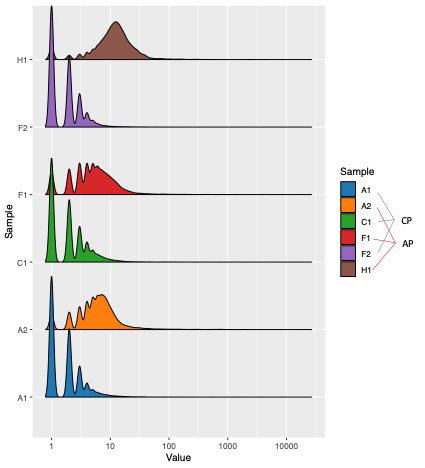Introduction: Myeloproliferative neoplasms (MPN) are characterized by a chronic phase (CP), with indolent clinical behavior and, in 10-30% of cases, progression to advanced phases (AP), with aggressive behavior and compromised prognosis. Numerous factors have been associated with progression to AP, including the acquisition of mutations in recurrently mutated myeloid genes (1,2). On the other hand, decreased diversity in the T-cell receptor (TCR) repertoire has been associated with worse prognosis in solid tumors. The purpose of this work is to study the correlation between the acquisition of mutations in myeloid genes and the diversity of the TCR repertoire in chronic and advanced myeloproliferative neoplasms.
Methods: Patients with chronic CP and AP myeloproliferative neoplasms were selected. The selected patients underwent an NGS panel of 48 myeloid genes. Only pathogenic (P) or likely pathogenic (LP) variants were considered. In parallel, the study of the TCR repertoire by NGS with the panel “AmpliSeq for Illumina Immune Repertoire Plus, TCR beta Panel” (Illumina™) was performed on the available samples. Finally, the obtained data were correlated. The study was approved by the local ethics committee.
Results: A total of 22 patients were selected, 10 in CP and 12 in AP. Regarding diagnosis, 8 were polycythemia vera (PV), 4 essential thrombocythemia (ET), 6 secondary myelofibrosis (MFS) (1 to PV and 5 to ET), 2 systemic mastocytosis (MS) and 1 primary myelofibrosis (MFP). Eighty percent were male and the mean age was 68 years. The AP patients were significantly older (74 vs. 62 years of age, p<0,001). Regarding the myeloid NGS panel result, 41 mutations were found in 19 patients. Fourteen percent of the patients had no mutation, 36% had an isolated driver mutation and 50% had additional mutations. Of these, 9% were in CP and 81% were in AP. The most recurrently mutated genes were JAK2 (45.4%), CALR (18.2%), ASXL1, IDH2, SRSF2, IDH2 (all 13.6%), MPL and KIT (both 9.1%). Regarding the results of the TCR repertoire, it was possible to perform the study in 11 patients, 4 in CP and 7 in AP. Only 6/11 had results of sufficient quality to allow analysis. Of these 6 patients, 3 were in CP and 3 in AP. As can be seen in Figure 1, the diversity of the TCR between CP patients and PC patients was different. Thus, while the pattern of diversity in the CP phase shows the expected distribution, the diversity in AP shows a characteristic pattern.
Conclusions: APs of MPNs show an abnormal TCR diversity pattern. This pattern may be related to the acquisition of myeloid gene mutations in AP. To our knowledge, this is the first study demonstrating an alteration in TCR diversity in AP and opens the door to future fields of research.
Disclosures
García Gutiérrez:Novartis: Honoraria, Membership on an entity's Board of Directors or advisory committees, Other: Travel grants, Research Funding; BMS: Honoraria, Membership on an entity's Board of Directors or advisory committees, Research Funding; Incyte: Honoraria, Membership on an entity's Board of Directors or advisory committees, Other: Travel grants, Research Funding; Pfizer: Honoraria, Membership on an entity's Board of Directors or advisory committees, Research Funding.


This feature is available to Subscribers Only
Sign In or Create an Account Close Modal